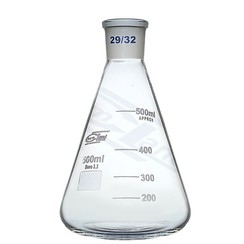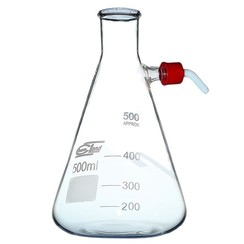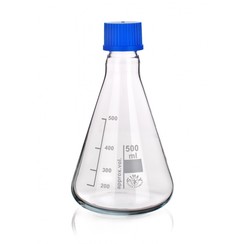You have no items in your shopping cart
Erlenmeyer flasks
The Erlenmeyer flask (synonym shaker flask) was developed in 1860 by Emil Erlenmeyer (1825–1909) - a German chemist. It is a glass vessel with a neck that narrows towards the top, unlike a beaker. It is used as a laboratory device. For laboratory use there are different versions of the conical flask, the narrow neck (DIN 12380 / ISO 1773) and wide neck shape (DIN 12385) with beaded edge and scale and, depending on the application, also flasks with standard ground joint (DIN EN ISO 4797) , eg B. also for nebulizers or flasks with iodine value with and without collar.
Due to the tapered neck, the risk of liquids escaping uncontrollably from the flask when adding substances, swirling, stirring or boiling is significantly lower than with beakers.
So you can comfortably mix liquids or speed up dissolution processes by - even relatively violently - vortexing or stirring. Just like the round-bottom flask, it is also suitable for the magnetic stirrer, but can be placed directly due to its flat bottom. (The round bottom flask, on the other hand, requires a cork ring or a tripod for a sturdy stand, the latter making it more difficult to swing by hand or check regularly by holding it up to the light.)
Thin-walled Erlenmeyer flasks should not be exposed to vacuum, as the flat bottom creates a risk of implosion. A thick-walled special shape of the conical flask is the feeding bottle.
Erlenmeyers are mainly made of glass (nowadays mainly borosilicate glass), but sometimes also of various plastics such as polycarbonate, polyethylene terephthalate copolyester (PETG), polymethylpentene, polypropylene or polytetrafluoroethylene (PTFE). Traditionally, conical flasks are closed with stoppers to prevent contamination, but there are also models with screw caps. Volumes range from 25 to 10,000 ml. Glass flasks are chemically resistant to solvents, strong acids or alkaline solutions and can be easily cleaned and autoclaved for multiple use. Plastic pistons, depending on the material used, are partially solvent resistant and autoclavable to a limited extent and are most commonly used as disposable items.
In the past, wide-necked Erlenmeyers were also called mouth monkeys.
Applications
Mixing: liquids can be mixed in the flask by swirling or stirring, suspensions can be kept stable or dissolution processes can be accelerated. The flat bottom ensures that conical flasks are stable and can be used on magnetic stirrers to mix materials. The cone shape and narrowing neck reduce the risk of splashing compared to open cups.
Heating: Glass Erlenmeyer flasks are suitable for heating liquids.
Culture of microorganisms: Mechanically shaken culture vessels are used to cultivate aerobic microorganisms, Erlenmeyers are very suitable for this. The flask filled with the liquid culture is moved on a shaking machine to keep the microorganisms evenly in the liquid and to promote gas exchange between the liquid and the gas phase. The size of the flasks used varies from milliliters to liters, depending on the application. Baffles (inward protrusions) in the flask increase the turbulence in the liquid when it is shaken, thus promoting the gas exchange between the liquid and the gas phase. This promotes the supply of oxygen and thus accelerates the growth of the cultivated organisms. This type of cultivation is often used before technically more demanding cultivations are carried out in the laboratory digester.
Oxygen supply in shake cultures
A sufficient supply of a liquid culture with oxygen and an optimal pH are basic requirements for all cellular processes. The oxygen concentration in liquid media is dependent on the amount of oxygen dissolved in the medium, the amount of oxygen in the gas phase above the culture medium and the amount of gas bubbles in the medium. For the efficiency of the oxygen input (volume-related mass transfer coefficient, synonymous kLa value) into the culture vessel, the size of the gas bubbles formed by mixing movements is of decisive importance. To reduce foaming, z. In some cases, anti-foaming agents were added, resulting in a significant reduction in the kLa value. Traditional stoppers and the length of the bottle neck also reduce the supply of oxygen to the liquid culture. In contrast, baffled conical flasks increase both the mixing of the liquid and the surface area available for oxygen transfer at the air-liquid boundary and thus lead to a better gas supply to the cells.
The monitoring of oxygen supply and other physico-chemical environmental parameters (eg PH value, concentration of dissolved carbon dioxide) in shake bottles is especially important in bioprocess technology to keep the living conditions in the liquid culture constant. In addition to classical chemical and electrochemical methods for determining the oxygen concentration, luminescence-based techniques are increasingly used today. The advantage of these optical measuring methods is that no oxygen is consumed in the medium, the measurement is independent of the pH value and ionic strength [8] and even several metabolic parameters can be determined in parallel under aseptic conditions without sampling. With this online control, critical process parameter concentrations in liquid cultures can be timely detected and corrected by changing medium or processing the culture.
For good aeration and mixing of the liquid culture, the rotation of the liquid "in phase" is also important, i. H. the synchronous movement with the shaking movement of the tray. The agitated culture may become "out of phase" under certain conditions. The liquid sloshes onto the bottom of the piston in an uncontrolled manner, resulting in poor mixing, reduced gas-liquid transfer and less power input. The main factor that causes a liquid culture to go out of phase is the viscosity of the medium. Small shaking diameters, low filling levels and many and / or large baffles also promote the change of state.






